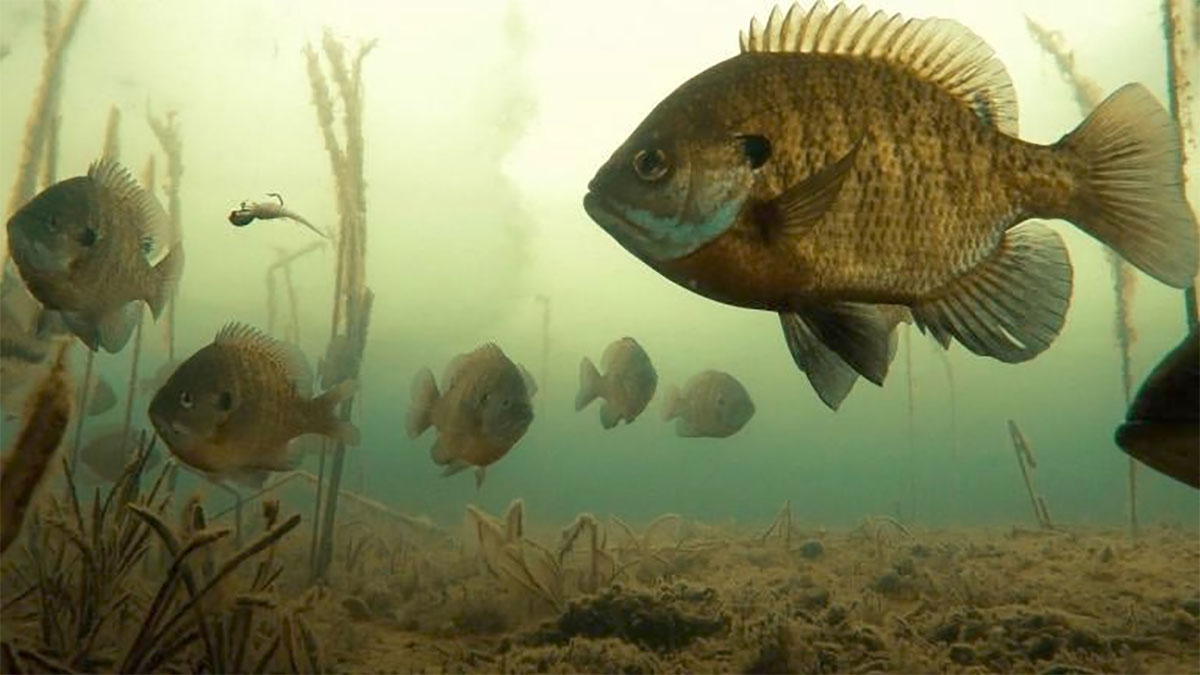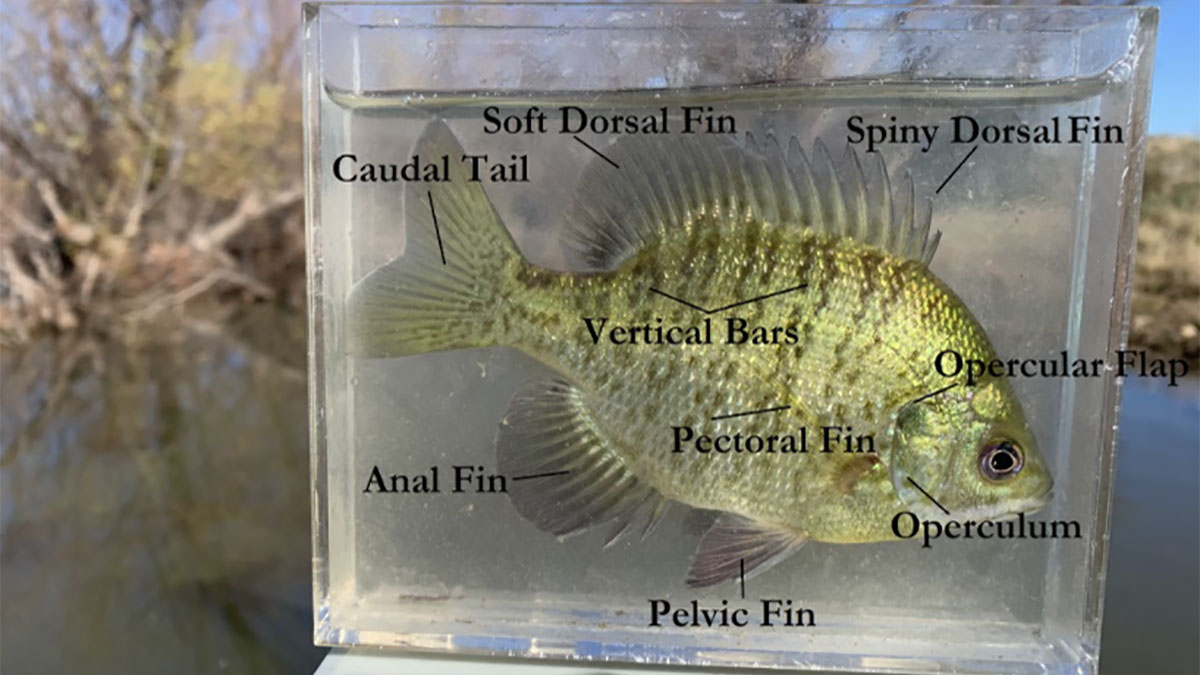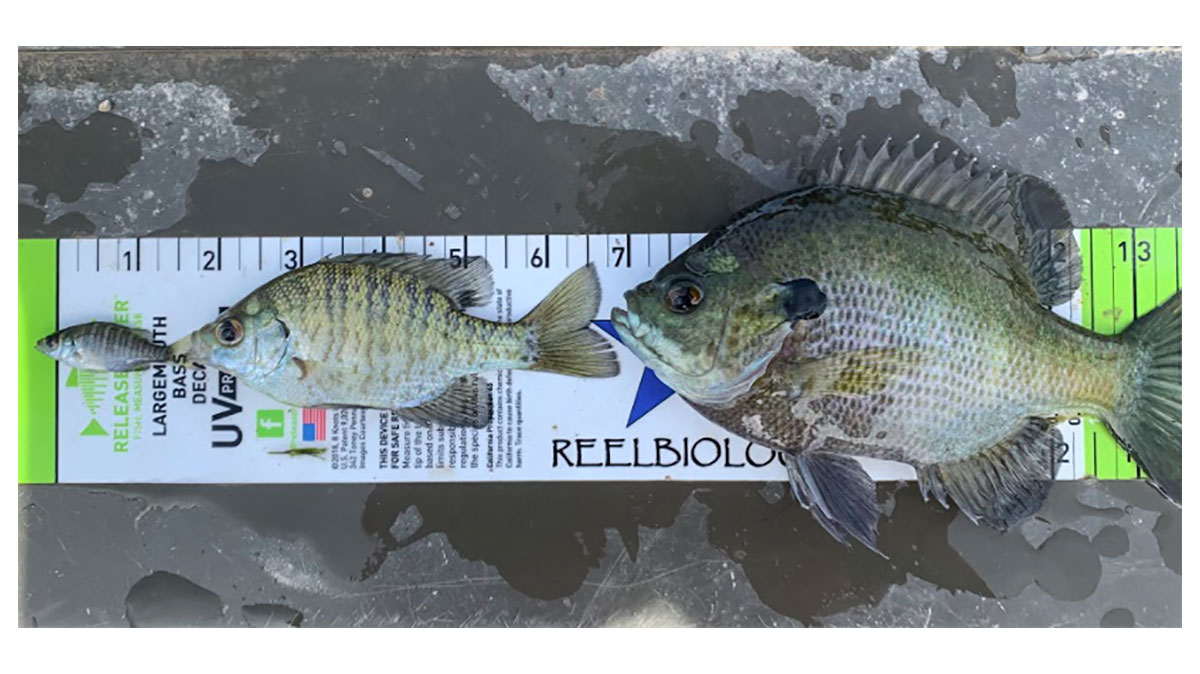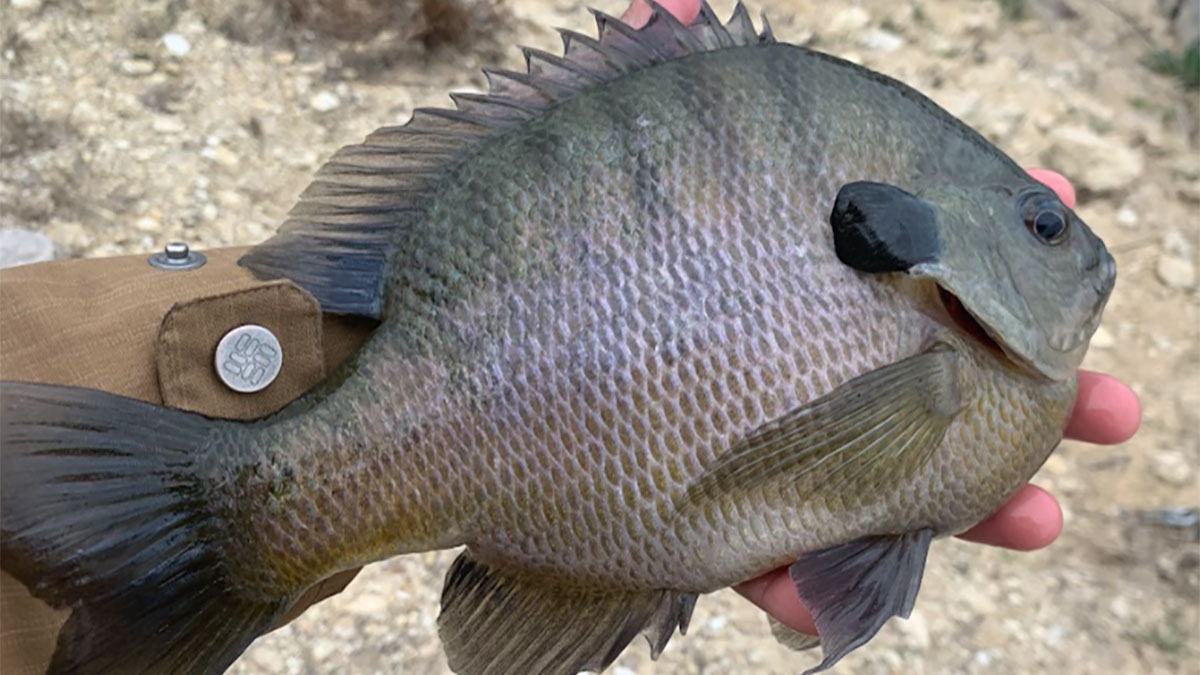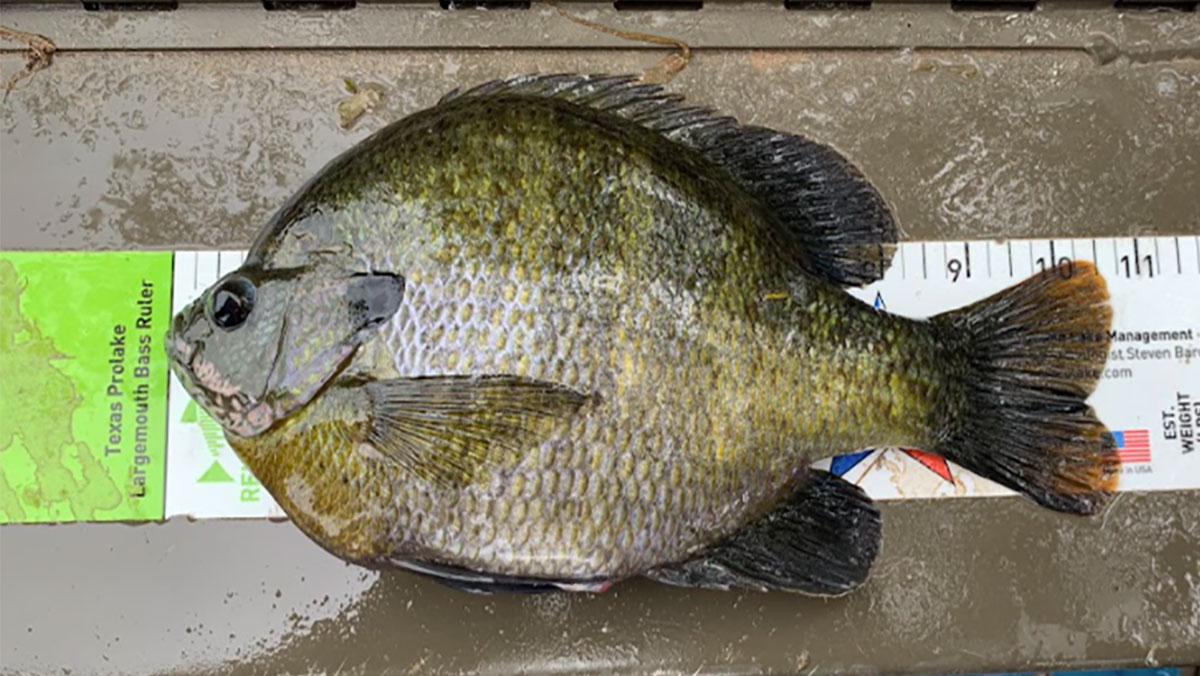Bluegill sunfish are a small-mouthed fish that have the ability to fight hard and taste delicious. Their popularity is unmatched with young and experienced anglers looking to test their light line and tackle. They also are mistaken for several other similar species, can hybridize with other species in the same genus and are sold commercially throughout the country. In this species profile, we cover everything you need to know about the bluegill sunfish.
Bluegill fishing can be an excellent way to introduce new anglers to sport of fishing. Not only are these fish plentiful throughout much of the country but they’re also excellent table fare and easy to locate and catch throughout much of the year.
BLUEGILL SUNFISH HISTORY
Bluegill sunfish Lepomis macrochirus is one of thirteen species within the genus Lepomis. This genus includes bluegill, redear (Lepomis microlophus), green (Lepomis cyanellus), pumpkinseed (Lepomis gibbosus), and longear sunfish (Lepomis megalotis). The Lepomis genus is part of the Centrarchidae family that includes largemouth bass (Micropterus salmoides) and black crappie (Pomoxis nigromaculatus).
Bluegill sunfish were officially identified and named by Constantine Rafinesque in an 1819 publication. Lepomis is Greek meaning “scaled gill cover” and macrochirus is Greek meaning large hand. The fish originally described was from the Ohio River and today would be considered to be a “northern” bluegill sunfish, as there are at least five subspecies of bluegill that have been identified. The subspecies include northern bluegill sunfish (Lepomis macrochirus macrochirus), coppernose bluegill sunfish (Lepomis macrochirus mystacalis), handpaint bluegill sunfish (Lepomis sp. cf. macrochirus), eastern bluegill sunfish (Lepomis macrochirus purpurascens), and southwestern bluegill sunfish (Lepomis macrochirus speciosus).
The southwestern bluegill sunfish subspecies may have not actually been a separate subspecies; it was observed in Texas and New Mexico and described in 1853. Today, however, there is no evidence this species exists. It possibly is extinct due to the introduction of northern bluegill sunfish or possibly the observed southwestern bluegill were just misidentified originally.
Bluegill sunfish have a ton of nicknames that include perch, bream, sunfish, sunnies, panfish, brim, slabs and coppernose. They are considered a panfish commonly harvested by anglers throughout the U.S..
BLUEGILL SUNFISH IDENTIFICATION
All Lepomis species have 3 anal fin spines, connected spiny and soft dorsal fins and an opercular flap or lobe that anglers often call an “ear”. Knowing opercular flap margin color, pectoral fin length and relative mouth size is essential to correctly identify a Lepomis species. It should also be noted that these species will readily hybridize making true identification in integrated populations very difficult.
Bluegill sunfish specifically will have a flexible operculum with an opercular flap that is slightly elongated and black. The opercular flap margin is also black to dark blue in color. The male bluegill sunfish will have a slightly elongated opercular flap compared to females, especially as they mature.
Bluegill have a total of 8 to 12 dorsal fin spines and 11-12 dorsal rays. The rear of the dorsal fin has a black false eye spot. The entire body of the bluegill sunfish is compressed and round, similar to a dish shape. The pectoral fins are elongated and if folded forward toward the mouth they will extend beyond the eye. The mouth will be smaller relative to their body size.
Coloration will vary with sex, males being more vibrant and colorful then females. The males will also become darker during spawning season. Bluegill will have a blue coloration on the lower portions of the jaw coming up to the side of the head. The body will typically be darker on the upper portions of the back with a brown, green or black coloration that fades to a lighter color at the stomach. The breast region of the fish can be a bright yellow coloration. The sides will have 5 to 9 vertical barring of alternating light and dark coloration that become less distinct at the tail. Water color and clarity can cause coloration to become difficult to observe.
Coppernose bluegill subspecies males can have a bar on the head above the eyes that appear to be lighter in color than the rest of the body with a copper coloration. The remaining body coloration of the coppernose is typically darker compared to northern bluegill sunfish. Handpaint bluegill subspecies will be similar in coloration to northern bluegill with several large dark blotches down their sides. Eastern bluegill sunfish species have an appearance more similar to coppernose bluegill sunfish.
BLUEGILL SUNFISH LOCATION
Bluegill sunfish are native to the United States to all areas west of the Rocky Mountains. Its southern boundary extended into northern Mexico along the Gulf Coast and throughout Florida. The northern boundary extended slightly into the southern parts of Canada and on the east coast they extended from Florida through Georgia, the Carolinas and stopped near Virginia.
The historic subspecies ranges are difficult to know as northern bluegill sunfish and coppernose bluegill sunfish are both sold commercially to private pond owners and fisheries managers throughout the U.S.. The coppernose subspecies was the primary species throughout Florida excluding the panhandle and southern parts of Georgia. The eastern subspecies overlaps the northern boundary of the coppernose and extends throughout the Carolinas. The handpaint subspecies was historically found in the Florida panhandle.
Today due to mass stocking programs using bluegill sunfish the northern and coppernose subspecies can be found throughout the entire United states, Hawaii, Puerto Rico, Mexico, Cuba, El Salvador, Panama, and southern parts of Canada. They can also be found in countries outside of North America including the Congo, Madagascar, Malawi, Mauritius, Morocco, South Africa, Swaziland, Zimbabwe, Iran, Japan, South Korea, Philippines and Venezuela.
To see the historic range of all the bluegill sunfish combined we have created an interactive map:
BLUEGILL SUNFISH SPAWNING
Bluegill sunfish are known as single nest spawners who select sites in close proximity to each other in a pattern that is similar to a honeycomb. This offers bluegill the ability to guard nests from each other as well as protect eggs and fry as a community. Bluegill mature based on age and size, in the southern United States maturity can be reached within their first year at 3 inches in length. In the northern boundaries of the bluegills maturity can take four to six years at a length closer to 6 inches. The number of eggs and their size will be directly proportional to the body size of the individual female bluegill. Most often males will mature more quickly compared to females.
The spawning season for bluegill corresponds to an increase in water temperature and length of daylight. Male bluegill will school early in the spring season selecting a community nesting size that is in shallow littoral zone areas one to three feet deep. The area will typically be near the shoreline with hard substrate and aquatic vegetation or hard structure in close proximity. Each individual male will clean an oval shaped nest by removing silt from the bottom by fanning their tails to expose hard sediment. The resulting nest will be 7 to 15 inches in diameter with depths varying with the sediment.
Active spawning will begin when water temperatures reach 65 degrees and continue throughout the spring, summer, and fall as long as water temperatures are below 85 degrees. In the southern reaches of the bluegill sunfish distribution when water temperatures exceed 85 degrees spawning can cease and restart in the fall once water temperature drops. Males attract individual females to the nest with bright coloration and territorial behavior.
Female bluegill sunfish eggs are small in size averaging around .04 inches in diameter with the potential to produce up to 80,000 eggs per year. Each spawning attempt will range from 2,000 to 20,000 eggs depending on the females age and size. Once the eggs are laid and fertilized females will leave the nest and attempt to spawn with other males or return to feeding areas until more eggs have become ripe. Males will continue to court multiple females into one nest and can accumulate in excess of 100,000 eggs. The eggs will be initially adhesive sticking to substrate and slowly become less adhesive and harder due to water exposure.
Paternal care is provided by the male for around 10 days, ending at the time of fry swim up. The males will primarily fan the sediment off of eggs and provide oxygen using their pectoral fins. When other males or predators encroach on the nest males will quickly charge them and can aggressively nip at or fight off intruders. The most common nest predator for bluegill tends to be other male bluegill sunfish, but not their neighboring males in the community.
Alternative spawning techniques have developed where “sneaker” males and “mimic” males also exist within some populations. Sneaker males will be smaller in size compared to dominant males that create nests. They can exhibit immature coloration as well. These males will wait outside of the nest and quickly swim into the nest during the act of spawning, attempting to fertilize the eggs while the dominant male is distracted. Mimic males will have female coloration and will enter into a nest with a dominant male and a true female. The mimic male will then attempt to fertilize eggs by participating in spawning along with the other two fish. Both of these alternative spawning techniques have been observed to be successful and minimize the potential risk of paternal care that dominant males will endure.
BLUEGILL SUNFISH SIZE AND LIFESPAN
Egg hatching time for bluegill sunfish will relate directly to the water temperature. In cooler water at 65 degrees it can take up to 3 or 4 days for an egg to hatch, in warmer water at 85 degrees this is reduced to 30 hours or less. Newly hatched fry will be around .1 inches in length and completely transparent. They will spend the first several days absorbing their yolk sac on the bottom sediment. At around 1/4 inch in length bluegill fry will have developed a body structure that allows them to begin swimming. Slowly they will continue to develop fins, scales and coloration. By 1 1/2 inches in length they will look adult like.
Growth rates will be primarily controlled by forage availability and temperature. In the southern US bluegill will grow around 2 to 3 inches the first year and an additional 2 to 4 inches per year after that. Their growth rates substantially increase in water above 85 degrees. This is likely due to the fact that they abandon spawning and focus exclusively on foraging. In cooler temperatures growth is slower with first year growth around 2 inches and an additional 1 to 2 inches per year after that. As a general rule male bluegill sunfish will grow to a larger overall size compared to females but live shorter lives.
The individual bluegill sunfish lifespan tends to be very short as almost every predatory fish will consume bluegill. Each year a large majority of bluegill are consumed creating Most bluegill in the southern US live to 5 years old where northern US bluegill sunfish live to 8 years. The maximum age observed of a bluegill is around 10 years.
The biggest bluegill ever caught weighed 4 pounds, 12 ounces and measured 15 inches. It was caught by T.S. Hudson in 1950 in Ketona Lake, Alabama.
BLUEGILL SUNFISH HABITAT
Bluegill sunfish prefer slow moving to stagnant water with abundant rock, aquatic vegetation or dense habitat. They can be found in most freshwater environments including ponds, lakes, reservoirs and slow moving streams or rivers. They can adapt to most water quality and tolerate brackish water with salinity over 15 ppt, temperatures up to 95 degrees and oxygen as low as 5 ppm.
Habitat preferences are primarily determined by the age and size of the bluegill, complexity and density of the habitat, time of year and forage availability. As a general rule bluegill sunfish prefer to be within the littoral zone of a waterbody throughout the majority of the year. The littoral zone is the part of the water column where sunlight can reach the sediment. It’s often characterized by being more likely to have aquatic vegetation, slightly higher dissolved oxygen and is above the thermocline. Habitat within the littoral zone will likely determine insect forage availability, with more insect biomass in dense and complex habitat types like aquatic vegetation. Juvenile bluegill within their first year will be found within aquatic vegetation and as they increase in size they will become more likely to be found foraging on outer edges of the vegetation. Throughout the year as vegetation becomes increasingly dense this difference in habitat preference will become more apparent. As fall and winter approaches larger sunfish will often move offshore to overwinter in deep water.
Wherever bluegill sunfish are found they are most likely in schools. Throughout the year bluegill schools increase and decrease in size from 6-10 fish to 100s. Many studies show bluegill are highly social fish really on the school for successful foraging and protection.
BLUEGILL SUNFISH DIET
Bluegill sunfish are considered to be insectivorous but truthfully they are primarily insectivorous with the ability to become omnivores as needed. Fry bluegill begin feeding by consuming microscopic plankton transitioning to zooplankton as they grow past 1/2-inch in length. At 1 inch they start consuming aquatic insect larva and larger zooplankton. By 3 inches the adult diet includes aquatic and terrestrial insects, zooplankton, crawfish, amphibians, eggs and small fishes. At times when insects are low, aquatic vegetation can account for 20% of the diet of bluegill. The bluegill does have quite a large overlap in diet preferences with other species creating intense competition for forage. There are times when the diet of bluegill sunfish will overlap juvenile largemouth bass, crappie and shad species. This competition can cause population level issues stunting either the bluegill or its competitors growth.
Bluegill have excellent eyesight feeding mainly by sight. They are also extremely nimble, using their pectoral fins to propel themselves both forwards, backwards and in circles quickly and quietly. They stalk prey, consuming them by swallowing them whole. Unlike bass species, bluegill rarely use their caudal fin to propel themselves. Their mouths have a slight protruding affect when opening, allowing them to create an oral negative cavity that provides a quick suction effect each time the mouth opens.
Bluegill feed primarily throughout the day, with feeding increasing beginning at sunlight and continuing throughout the day ending at sunset. Anglers can take advantage of the aggressive nature of bluegill spawning activities and their indiscreet daytime feeding habits to catch bluegill using dozens of techniques.
To increase your chances of catching both quality and quantity, it’s essential to use the best bluegill bait while you’re fishing. They’re fairly susceptible to both live bait and artificial lures, so whatever your preference, you can have an awesome time catching these fish. Heck, you can even use this trick to make your own DIY homemade bluegill bait.
BLUEGILL SUNFISH THREATS
The bluegill sunfish is one of the least threatened species at a population level. Their long spawning season and high reproductive numbers allow them to bounce back quickly even from mass mortality events. However, their ability to hybridize with other Lepomis species, the competition created from overlapping diet preferences, their vulnerability to predation and the popularity of angler harvest make them susceptible to disparity in populations. Long term, some of these issues can compound leading to the stunted bluegill population. Management of bluegill sunfish can be tricky and divisive as the number of individual bluegill can rebound quickly but growth to catchable, harvestable or trophy-sized takes several years.
BLUEGILL SUNFISH FACTS YOU NEED TO KNOW
- The IGFA world record bluegill sunfish weighed 4 pounds, 12 ounces and was caught by T. Hudson on Ketona Lake in Alabama.
- The IGFA world record longest bluegill sunfish is 11.81 inches and was caught by Joshua Daniels in the Colorado River in Arizona.
- T. Hudson’s bluegill sunfish was 15 inches long with an 18-inch girth.
- The oldest aged bluegill sunfish was 11 but aging was from a scale so that’s the scales age so the fish could have been older.
- Bluegill sunfish are the Illinois state fish.
- Bluegill sunfish can be used as bait in 20 states.
- You can legally buy bluegill sunfish in all lower 48 states for your personal pond.
ABOUT THE AUTHOR
Steven Bardin obtained his bachelor’s degree in Freshwater Biology from Tarleton State University in 2009 and his master’s degree in Fisheries Science from Texas A&M in 2013. While at Tarleton, Bardin worked for Harrell Arms at Arms Fish Farm and Bait Company. In 2011 he founded Texas Pro Lake Management. He strives every day to take a scientific approach to helping his clients maximize the production of their fisheries.
Outside of TPLM Bardin has written for Wired2Fish, taught as an adjunct professor for Tarleton State University, and served as an instructor and camp coordinator for Bass Brigade youth leadership camp. In 2021, Bardin helped Major League Fishing found their Fisheries Management Division and leads their conservation efforts today.
Bardin is a member of Texas Aquatic Plant Management Society, Texas Chapter of American Fisheries Society, Southern Division of American Fisheries Society, Society of Lake Management Professionals, Texas Freshwater Fishing Hall of Fame Board, Texas Brigades Board, Texas Freshwater Fisheries Advisory Committee and the Major League Fishing Anglers Association Board.


